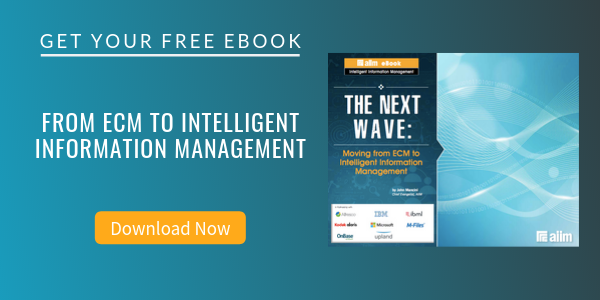
8 Factors to Consider When Evaluating a Next Generation ECM Platform
Enterprise Content Management (ECM)
1. Look at New Approaches to Software Acquisition
Back at the turn of the century (yes, we mean the late 1990s...), there was but one way to acquire a content management product to meet enterprise document or records management needs. We bought per-seat or per-server licenses that shipped on CD from the software vendor, crossed our fingers that we budgeted for enough seats or connections for key employees, all while hoping that the vendor roadmap delivered the fixes and features we quickly realized were missing.
In 2010 things are different. The options to acquire ECM software have changed dramatically, offering a far richer range of choices to serve customer needs—not just those of the vendor. Open source and Software-as-a-Service (SaaS) are two new approaches that put power back into the hands of the enterprise. Simple, clear online downloads or subscription sign-ups via the web cut through the red tape of license keys, the endless sales cycle theatrical negotiations, and lets your team get started on an ECM project today.
2. Interoperability is Hot. Closed Systems are Not
2010 will be the year that content silos get harvested—not busted. When evaluating your next-generation ECM platform, watch for vendor commitment to new standards such as CMIS (Content Management Interoperability Services). Many businesses today are challenged by content sitting in multiple document repositories, requiring costly and complex custom integrations to make it useful. The next wave of ECM will take this burden off of customers and build interoperability into core products. Watch for the vendors that are quickly building applications and integrations to help fuel quick solution delivery. CMIS integration today helps to bring managed content into BPM, WCM, portal, or mobile-based applications quickly and with minimal re-coding needed to support new third party products.
3. No Longer does the Vendor have to be in control of your Company’s ECM Roadmap
Would you be surprised to know that your company has more software developers on the payroll than even the leading ECM vendors? Government, financial services, and other large enterprises understand the value of having enterprise architects, information architects, and application development expertise in-house. Companies that are innovators in their own markets, and that understand the value of technology to stay competitive, responsive and efficient, are becoming impatient with vendor roadmaps and release cycles that don’t line up with their priorities. Next-generation ECM platforms that have active community engagement and use open source development practices give a tremendous advantage to organizations who want to deploy quickly, fix critical issues or create their own feature extensions—because the customer knows their business better than anyone else.
4. Compare your ECM Growth Plans with Vendor License Models
If your ECM vendor inhibits your organization’s information management strategy adoption, product roll-out, or application extension because of per-user license restrictions and limitations, it’s time to look at alternatives. Next-generation ECM platforms are not hobbled by the leftover client-server licensing model of the last century. In the world of the web, the burden of every new user added to the application is negligible—so why are we charged this way? Organizations that are on a growth path that have merger/acquisition plans, or that simply want to be more holistic in their content management goals need to align with a vendor engagement model that supports their business goals—not with vendors that present costly barriers to natural growth.
5. ECM Market is Differentiating: Platforms vs. Suites vs. Condominiums
An ECM Platform is a cohesive, end-to-end offering architected and built by a core team with a common vision (vendor or community). It is a foundation for the content or case-centric applications that business users need. Platforms are intended to be used as infrastructure: the plumbing to make the business run in the knowledge economy. This ecosystem of services, plug-ins, APIs allows organizations to be the makers - building the applications that are meaningful to their information workers and business objectives.
Several of the ECM suite vendors have been acknowledged as the “leaders” of this last decade. Feature-rich product portfolios are assembled via acquisition - less organic internal R&D strong point solutions, integrated at wildly different levels of depth. The suite approach helped make sense of the diverse content management applications that emerged in the 1990s and needed to be consolidated. Increasingly this is the mark of the ‘old guard’ legacy ECM vendor.
We are now in the world of the web, and mobile, and social. Information workers aren’t afraid of technology and new devices anymore. One size fits all apps that are tough to customize and tailor to specific business processes that are frustrating to end-users and systems administrators alike. When the capabilities that sold the ECM suite are actually from entirely different products - different installers, system requirements, administrative modules, support for standards—tasks are burdensome for administrators.
And the Condominiums? Some of the Suite vendors are more cohesive in their vision and architecture than others. If every feature used to be a company... if it looks like a nice building from the outside, but through the front door you realize every unit has a separate owner... and is decorated differently... every room has its own rent schedule...and the resident’s association won’t let you change anything... some floors are well maintained, and others left unrepaired... well then it might not be a Suite... but a Condominium.
6. Generic DM and RM Don’t Cut it Anymore
Measurable resources—time and money—are what business managers worry about. General-purpose deployments of ECM products generally don’t cut it anymore. Businesses are under pressure to constantly improve results, meet internal quality or external compliance mandates, discover efficiencies, and automate routine tasks. ECM products that are time-consuming or costly to customize for specific business scenarios, or integrate into other key line of business applications risk low levels of user adoption and thus poor ROI. Your next generation of ECM platform needs to be built for rapid application deployment. Find the tool that lets your internal business analysts or content architects whip up document types, lifecycles, shortcuts, new metadata, or vocabularies to meet fast-paced business shifts in hours or days—NOT weeks or months.
7. Is it Time to Future Proof Your Roadmap?
The ECM product landscape is littered with neglected and unloved solutions that got caught on the wrong side of a vendor acquisition. Has your license investment and ongoing maintenance fees only bought you the headache of migration to the vendor’s preferred product? Often yes. Next-generation
ECM platforms that have a strong independent community through open source development practices build in an extra layer of ‘future-proofing’ insurance: no one corporate interest can completely set the roadmap. Active and engaged customer and partner communities have the opportunity of continuing the development and evolution of products that are developed in the open. In this case, the customer is always right and has the power to control its own ECM destiny.
8. Find Better Protection for Customization Investments
Upgrades and patches are a natural part of the software world—no one should expect to stay on the same version indefinitely. Yet so many ECM deployments do languish on outdated releases, risking the loss of user engagement, forgoing integration with new office applications, or missing out on cool new features that could solve many help desk complaints. Why? Because the customizations are done for legacy ECM products are so rarely portable to newer versions, either completely incompatible or require a rewrite that is too costly to pursue. Businesses that are serious about incorporating content applications into their core processes can’t be shackled to old, outdated systems. Agile is a state of mind for successful enterprises today—constant tailoring, tweaking, improving helps tune how the business runs, and ECM platforms should be able to easily keep up with ongoing innovative iterations demanded by business analysts and content architects. Your next-generation ECM platform should have the tools, design environments, and extensible nature that’s designed to be shaped for your business. No longer should your content management choice be a burden that holds back your corporate evolution.
About Cheryl McKinnon
Cheryl McKinnon is a principal analyst at Forrester Research, serving enterprise architecture professionals; she helps them support their firm's need for content and collaboration technology capabilities in the age of the customer. Cheryl delivers research and advisory services in areas including enterprise content management (ECM), content archiving, enterprise file sync and share, document-centric collaboration, life-cycle management, information governance, and file analytics.



